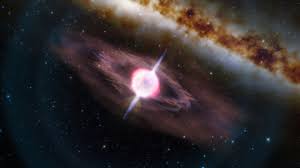GRB 200826A: Gamma-Ray Burst:

A group of astronomers have detected a very short, powerful burst of high-energy radiation also known as Gamma-Ray Bursts (GRBs) that lasted for about a second.
- It was named GRB 200826A after the date it occurred, which is 26th August 2020.
- It was detected by National Aeronautics and Space Administration’s (NASA’s) Fermi Gamma-ray Space Telescope.
Gamma-Ray Bursts:
- They are the most powerful events in the universe, detectable across billions of light-years.
- A light-year is the distance a beam of light travels in a single Earth year, or 9.5 trillion kilometers.
- Astronomers classify them as long or short based on whether the event lasts for more or less than two seconds.
Long GRBs:
- They observe long bursts in association with the demise of massive stars.
- When a star much more massive than the Sun runs out of fuel, its core suddenly collapses and forms a black hole.
- Black hole refers to a point in space where matter is so compressed as to create a gravity field from which even light cannot escape.
- As matter swirls toward the black hole, some of it escapes in the form of two powerful jets that rush outward at almost the speed of light in opposite directions.
- Astronomers only detect a GRB when one of these jets happens to point almost directly toward Earth.
- Each jet drills through the star, producing a pulse of gamma rays – the highest-energy form of light – that can last up to minutes.
- Following the burst, the disrupted star then rapidly expands as a supernova.
- A supernova is the name given to an exploding star that has reached the end of its life.
Short GRB:
- Short GRB, on the other hand, forms when pairs of compact objects – such as neutron stars, which also form during stellar collapse – spiral inward over billions of years and collide.
- A Neutron star comprises one of the possible evolutionary end-points of high mass stars.
GRB 200826A:
- It was a sharp blast of high-energy emission lasting just 0.65 seconds.
- After traveling for a very long period of time through the expanding universe, the signal had stretched out to about one-second-long when it was detected by Fermi’s Gamma-ray Burst Monitor.
- It had been racing toward Earth for nearly half the present age of the universe.
- It is considered to be the the shortest GRB till now and it occurred caused by the death of a massive star.




